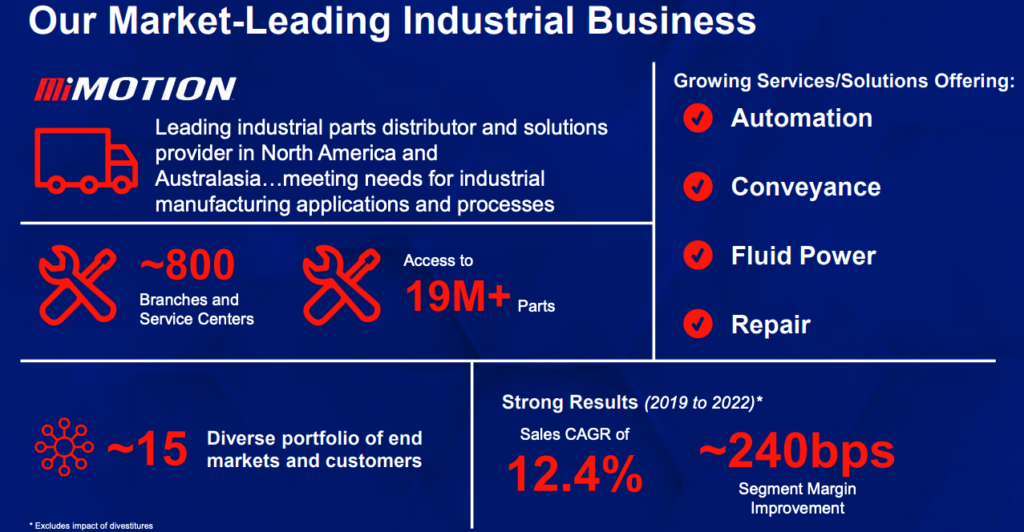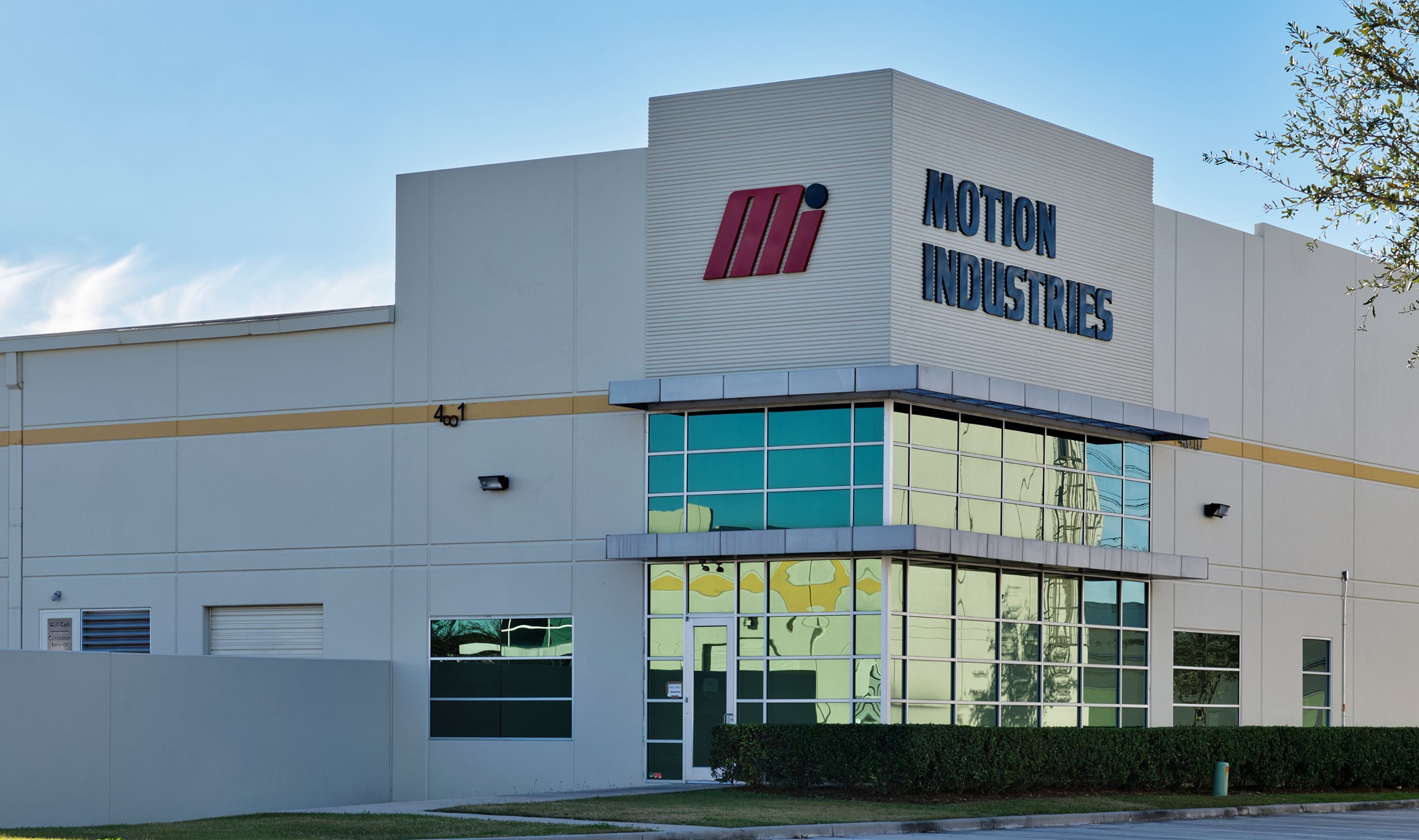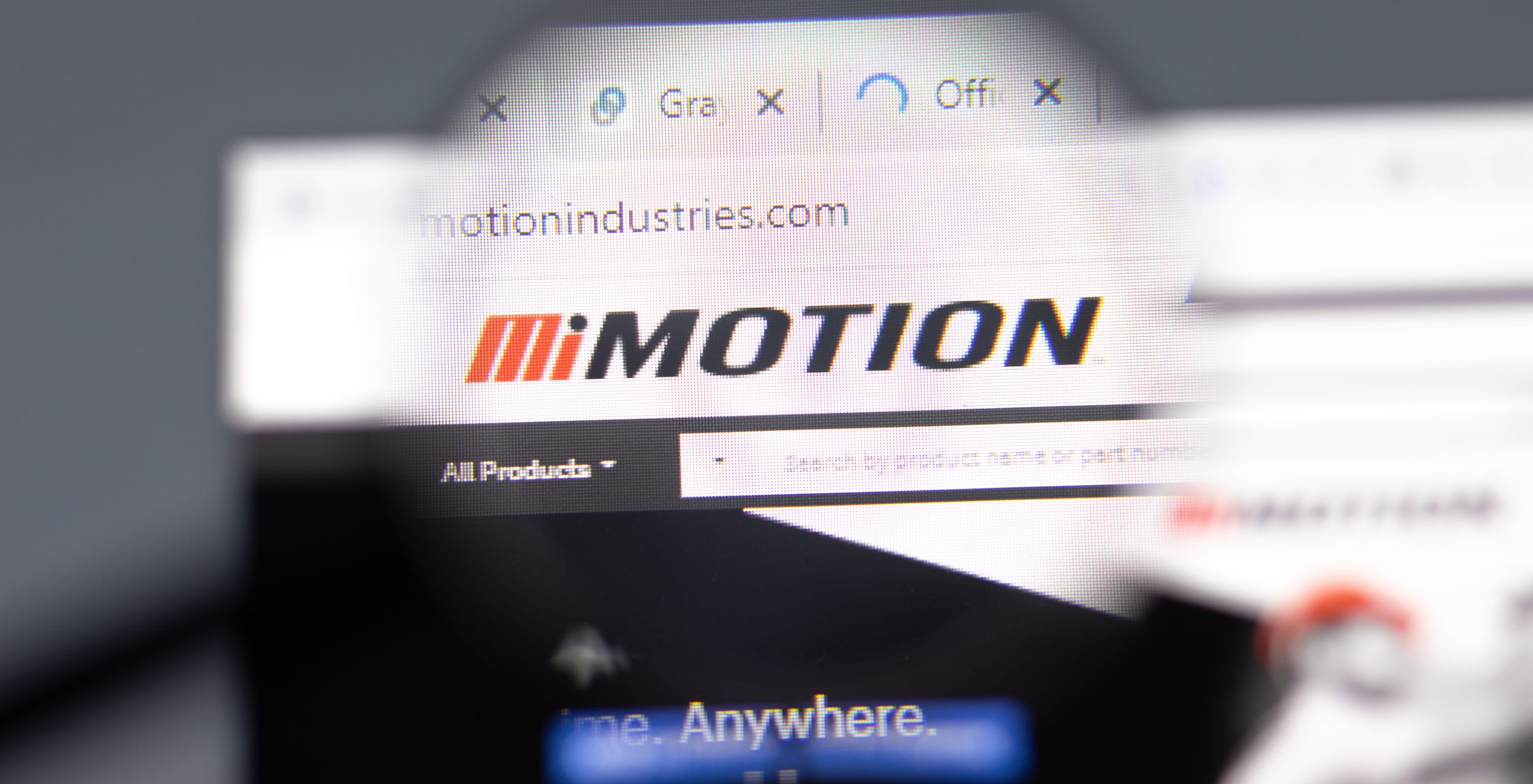Power transmission and MRO supplies distributor Motion has been on a multi-year digital and sales transformation journey that has led the company to achieve a sales CAGR of 12.4% from 2019 through 2022 alongside 240 basis points of net margin improvement in that stretch.
Throw in its landmark $1.3 billion acquisition of Kaman Distribution Group completed at the start of 2022 — which combined MDM’s No. 1 and 3 power transmission and fluid power distributors — and it paints a picture of organizational change on a large scale.
Motion had 2022 sales of $8.4 billion, which charted it at No. 2 on MDM’s 2023 Top Industrial Distributors List, trailing only Grainger. The company has about 9,000 employees, and operates as a business unit of Genuine Parts Company.
At MDM’s September 2023 SHIFT Conference in Denver, Motion Executive Vice President and Chief Operations Officer Joe Limbaugh joined MDM CEO Tom Gale on stage for a fireside chat to dive into this transformation story.
In this Premium piece, we’ll extract takeaways shared by Limbaugh, which focused on Motion’s transformation to a stronger hybrid sales model and a digital-first organization.

Motion’s Identity Question Sparks Transformation
Pre-2018, Motion certainly was a successful large distributor in terms of growth. Coming out of an industrial downturn in 2016 in which the company’s annual sales dipped 0.2%, sales rebounded in 2017 ($5.8B) and 2018 ($6.3), growing 7.5% and 8.5%, respectively.
But while the company’s revenue growth was sound, Limbaugh acknowledged that the company was lacking on the innovation front and was a provincial organization. That began to change in late 2018 with the appointment of company veteran Randy Breaux as Motion’s President, who previously served as its marketing and strategic planning leader for seven years.
Limbaugh said Breaux got the transformation wheel rolling with an existential question.

“He had the courage to bring the executive team together and ask, ‘Who are we, and what do we want to be? Where are we going, and where do we want to go?’” Limbaugh told the SHIFT audience. “This was the genesis to figure out how we were going to position ourselves for the next five to 10 years. It started with that challenge.”
Breaux was promoted to North America Group President of GPC as of July 2023.
To answer those questions, Motion had to first get a solid picture of the then-current state of B2B distribution. And to do that, it had to look beyond its internal — though extensive — industry experience. That meant relying on consultancy data, industry whitepapers, voice-of-the-customer research and employee feedback.
“You get a bunch of egocentric executives in a room and we think we know it all, when in fact we don’t,” Limbaugh said. “So we wanted to have a gut check on what we thought we knew about ourselves and accept that a lot of it would have to come through outside information. Where we needed to be began to emerge from the fog.”
Limbaugh added that Motion’s leadership team believed that its biggest disruptor would be unknown, which has proven true through today. Information about competitors is common knowledge, but disruption in B2B markets continues to come from unlikely places — a global pandemic being the most obvious recent example.
“We wanted to make sure that we were in control of our destiny,” Limbaugh said. “We believe that the best way to predict the future is to create it, and that was the idea that we took on.”
At different points over the past several years, MDM has discussed this topic of distributors’ self-identity question, notably in the form of finding a “North Star” as a guiding principle that a distributor can follow as its underlying purpose and value.
It appears Motion made finding its North Star a top priority soon after Breaux became its president. Its guiding principle centers on transforming from a traditional footprint that relies on a hub-and-spoke model that leverages distribution centers and branches to a model that prioritizes fulfillment centers and caters to customers’ digital-first buying habits. This transformation, Limbaugh emphasized, is ongoing.
Once its guiding principle was identified, Motion had to determine the change management pieces that would help it pursue the company’s overarching goals. Limbaugh detailed those in a few different pillars: talent and culture management; supply chain and sales operations; technology integration; and data analytics.

Talent & Culture Management
Limbaugh said that, pre-2019, Motion — like most large selling organizations — had a talent structure where staff would rise to higher levels of success based primarily on their ambition and aptitude, but also largely upon whether or not they were willing to relocate to take a higher position. That latter barrier to upward mobility, he said, resulted in Motion having the provincial look he noted earlier.
“Today that’s changed because of the way we use data and where we recruit our talent,” he said. The company’s talent structure began to change by 2020, and the pandemic’s work environment impacts only accelerated it. “There is a lot of energy and creativity coming from different parts of the world as we staff our organization, and I think that has been a lot of the thrust behind us being able to move as quickly as we have.”
Business transformation is challenging, and the larger the organization involved, the more potential there is for staff who aren’t entirely comfortable with it. Gale asked Limbaugh how to best manage a team that might have some individuals who embrace changes in culture and processes; some who voice plenty of concerns; and those who outright resist changes.
“You’re always going to deal with that type of discomfort when you’re walking across broken glass barefooted,” he said. “The right thing is to understand and believe in what it is you’re trying to do. You have to understand what you are doing so well that you can articulate and argue it at any given point. You have to have conviction in it. If not, it’s going to be even harder than what you need to do.”
Limbaugh went on to elaborate on the importance of transparent communication during business transformation to avoid surprising anyone. He admitted that it’s something he could’ve done better with in 2019 and 2020.
“It’s not that I didn’t want anybody to know, it’s that it didn’t seem important because we were doing so many other things,” he said. “In the end, there were a few times that came back and bit me.”
As the company created the “new” Motion — which included shortening its branding from Motion Industries to just Motion at the start of 2021 — Limbaugh embraced transparency in his leadership style. He keeps an open-door policy at Motion’s Birmingham, AL headquarters offices, which he said helps the messaging he and his fellow executives convey.
“You can’t hide in your office if you’re going to transform the organization,” he said. “You can be one of two leaders: the one who manages from the ivory tower, or the one who brings water to the troops. I like bringing water to the troops because that’s where I came from. I started as a delivery driver (in 1983 with Berry Bearing Company, which was later acquired by Motion). I understand the trials and tribulations there, and I get energy from it. It reminds of me where the real work is being done. I think you have to be available to your teams at every level so your message doesn’t get diluted.”
He also advised on the tough personnel decisions that often accompany large-scale transformations.
“Invariably, there are going to be people who are up for the task and people who aren’t, and that’s the painful decision,” Limbaugh said. “Do you find a better place for them in the organization? Do you reintroduce them into the workforce and bring in somebody else? The answer is yes and yes. You’re not going to get there on your own.”

Supply Chain & Sales Process
Limbaugh had an interesting analogy for the synergy between Motion’s sales and supply chain teams as they’ve adapted to today’s B2C-driven customer expectations of a digital-first buying experience.
“Sales has to kill the bear, supply chain has to skin it,” he told the SHIFT audience. “Supply chain supports the brand promise in our organization.”
He elaborated that while a distributor’s supply chain team isn’t making the sale, all it takes for a customer is one bad supply chain experience for a once-good relationship to crumble.
Limbaugh said the supply chain at Motion boils down to five things: what you buy; how you buy it; from whom you buy it; how you receive it; and final mile delivery.
“What we did at Motion was take each of those apart and reconstitute the teams in the process to take advantage of data to meet that customer expectation of today.”
As Amazon and Amazon Business rapidly gained B2B supply market share over the past decade, it lit a fire under many distributors to invest in eCommerce, marketplaces and other digital channel offerings for their customers. At the same time, it encouraged distribution executives to make a tougher and more holistic examination of their digital strategy, rather than just trying to emulate the same experience that Amazon does.
Limbaugh said the disruptor that is customers’ evolving expectations has also presented an opportunity for distributors to address multiple touchpoints simultaneously rather than view them as individual eCommerce, supply chain or sales problems.
“If you’re really going to transform, if you’re going to solve a problem — before you start beavering away at it, stop and stand back and ask the question, ‘What can you accomplish along the way?’” he said. “When was the last time you looked at how those delivery vans were stylized? When was the last time you thought about the customer experience from a receiving standpoint? Don’t just fix the thing at hand. Step back and say, without project creep, ‘What else can we catch along the way?’ It’s easy to get fixated on one or two elements of it and leave a lot of opportunities on the table.”

Don’t Let Tech & Data Become Distractions
In this age of technology proliferation in distribution, executives have seemingly endless tools to choose from that can help their business. But with so many options, it’s also easy to either contract decision paralysis and not pick one at all, or be trigger-happy and invest in a tool without properly vetting it.
Limbaugh has found the key to successful tech adoption has been in defining its purpose.
“I like bringing in technology to solve a problem,” he said plainly. “Sometimes I find that people use technology as a solution looking for a problem, which can create confusion in what you’re trying to do. What I do in my areas of supply chain marketing and others is to say, ‘What is this technology? Is it an arrow in the quiver, or is it a distraction?’ There must be a compelling reason to bring forward this technology investment. If it’s sound, we’ll climb over it. But if it’s not, we’ll park it for another time.”
Plenty of distributors voice their embrace of data and being a data- and technology-driven organization rather than one driven by the ways things have always been done and gut-feel assumptions. Limbaugh acknowledged the value of having that kind of progressive culture but warned about becoming blinded by it.
“Data is the Rosetta Stone in understanding how you can scale your operations and meet customer expectations. The problem that one can face is becoming confused by it,” he said. “You can become drunk with data and it can create analysis-paralysis with meeting after meeting. At some point, you have to say, ‘That’s fascinating, but let’s just stop and do something. We’re headed this way and need to go a different way.’”
“This is the danger of data,” Limbaugh continued. “Like with technology, you need to set boundaries around data to use it in a way that gets you where you want to go. Your strategy and business planning have already given you direction. Don’t become distracted by data or technology.”

Motion Today
A Nov. 27 news release from Motion stated that, worldwide, the company now has more than 750 branch and service center locations and 35 distribution centers, with 600+ branches and 19 of those distribution centers in North America. Combined, Motion’s global footprint has access to over 19 million industrial parts and serves more than 200,000 OEM and MRO customers in the industries of equipment and machinery, food and beverage, pulp and paper, iron and steel, chemical, mining and aggregate, petrochemical, automotive, semiconductor, wood and lumber, medical and pharmaceutical.
For the trailing 12 months at the end of Motion’s third quarter (ended Sept. 30), the distributor had a net profit margin of 12.0%, outpacing the 8.5% at GPC’s Automotive unit (NAPA Auto Parts).
GPC identified Motion’s growth opportunities to include:
- Omni-channel buildout & eCommerce acceleration
- Expand industrial services & value-added solutions capabilities
- M&A to further boost product & service offerings
- Enhance pricing & product category management
- Network optimization & automation for improved productivity
GPC estimates that North America’s addressable industrial products market is valued at approximately $150 billion and that Motion owns about 5% of it.
Along with Limbaugh’s promotion to EVP and COO, Motion’s 2023 included appointing a new CFO, a new Chief Commercial Officer/Chief Technology Officer and a leader for Motion’s new Automation Intelligence unit.
KDG integration update: Limbaugh shared that Motion’s integration plan for its January 2022 acquisition of Kaman Distribution Group originally spanned 36 months, but that timeline was shortened by about half due to both companies’ close cultural alignment.



